Otobong Nkanga, was born in Kano, Nigeria in 1974, grew up in Lagos and Paris, and lives and works in Antwerp, Belgium. Over the past 20 years she has been producing evocative works that speak to migration and her own movement in the world, the exhaustive use of planetary resources, and the interconnectedness of people and the land. Her enigmatic art, which relies on extensive research into the places it inhabits, frequently uses raw materials such as minerals, metals, stones, and plants to elicit new meanings, stored memories, and emotional connections for her audience.
“The work of Otobong Nkanga makes manifest the myriad connections—historical, sociological, economic, cultural, and spiritual— that we have to the materials that comprise our lives,” says Nasher Sculpture Center Director Jeremy Strick. “Delving deeply into the variegated meanings these materials take on, Nkanga’s work makes clear the essential place of sculpture in contemporary life.”
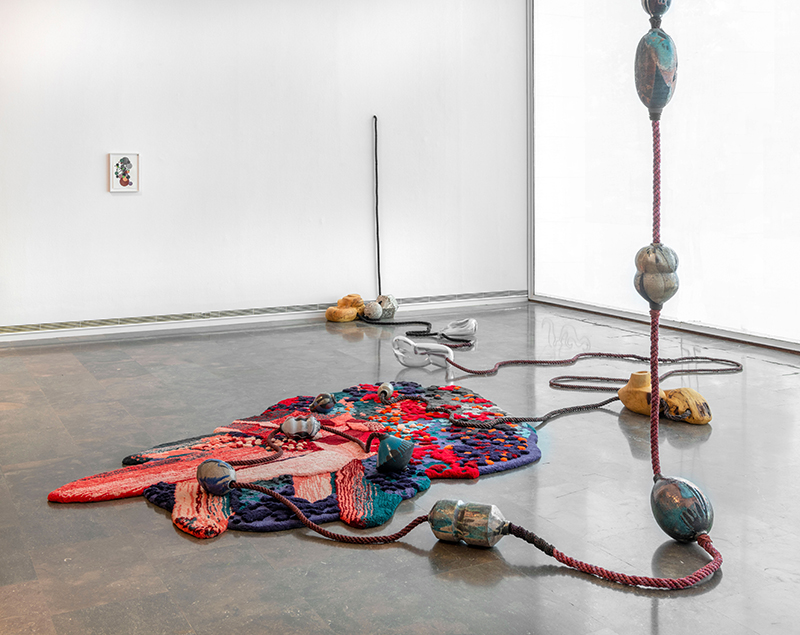 Otobong Nkanga (Nigerian/Belgian, b. 1974)
Otobong Nkanga (Nigerian/Belgian, b. 1974)
Loaded tears turned to rock, 2023
Hand tufted carpet, Murano glass, wood, ceramic, clay, handmade rope, metal connectors
Installation view of Craving for Southern Light at the IVAM Centre Julio González, 2023
Photo: IVAM Centre Julio González
Marble, mica, and kola nuts, as well as fabric, soap, and hand-blown glass, characterize the artistic practice of Nkanga, who brings these together in works combining sculpture, drawing, painting, photography, tapestry, performance, and installation. Often, her projects begin with research into a specific place or situation, accompanied by questions: how can we care for what is uncared for? how do we put light on things that are being obscured?1 which body tells the stories found in the archive?2 From such queries, Nkanga creates artistic encounters that encourage viewers to engage, respond, and consider their relationships to art and to one another. She frequently builds connections that traverse geographical, historical, and social differences, forming constellations between points sometimes considered in terms of existing intellectual frameworks, such as the Anthropocene (a term for the current geological age, defined by the impact of human activity on the environment). Although Nkanga’s art touches upon subjects and issues often identified with such rubrics, she seeks more nuanced, open-ended ways to explore their context and underlying conditions. As she put it in a 2013 interview, “The amazing thing is that our planet has so many hidden secrets, altered histories, and forgotten stories, that it is such a resource to delve into, photograph, research, learn, and share.”3
Nkanga’s work frequently focuses upon the land and the substances and people associated with it. When discussing Landversation, a project that first occurred in 2014, she explains, “What I mean with regards to the notion of ‘Land’ extends beyond just soil, territories, earth, etc. but relates to our connectivity and conflicts in relation to the spaces we live in and how we humans try to find solutions through simple gestures of innovation and repair.”4 Research is also a key element of her practice, whether to learn the human and natural history of a specific place or substance, or to consider the way that objects and people can change as they move (or are moved) from place to place. Far from being academic, Nkanga’s research can extend to personal experiences, encounters with others, and meditative reflection.
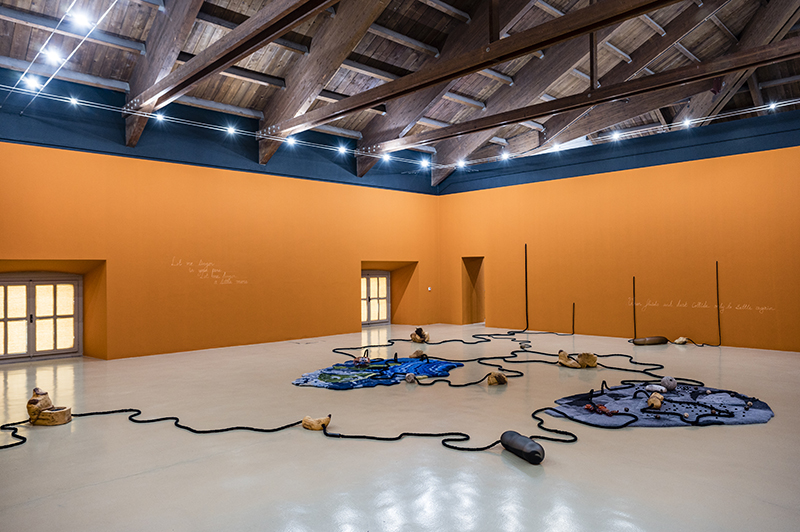 Otobong Nkanga (Nigerian/Belgian, b. 1974)
Otobong Nkanga (Nigerian/Belgian, b. 1974)
Leaving trails in the distance, 2021
Wool carpet, cotton hand-knotted ropes, weeping beech wood sculptures, hand-blown glass sculptures, clay sculptures, metal, sound, organic materials and various oils
Lined with shivers sprouting from the rock, 2021
Wool carpet, cotton hand-knotted ropes, weeping beech wood sculptures, hand-blown glass sculptures, clay sculptures, metal, video, organic materials, and various oils
Installation view of Otobong Nkanga, Of Cords Curling around Mountains /Corde che si arricciano attorno alle montagne at the Castello di Rivoli Museo d’ArteContemporanea, 2021
Photo: Andrea Guermani
If Nkanga’s work draws on the logic of etymologies—delving into the various origins of meaning behind objects—it relies equally on the artist’s intuition and emotional response. She has written poetry for some time, freely associating words, sounds, and ideas to go beyond the rational or prosaic. Recently, the artist has incorporated into her installations these elements of sound and language, playing with their malleability to elicit a range of reactions. In Of Cords Curling around Mountains (2021–22), an installation at the Castello di Rivoli in Turin, Italy, islands of irregularly shaped rugs, inspired by minerals under magnification, were laid throughout the galleries and connected by ropes strung through hollow objects of wood, ceramic, and glass. These containers held materials often used for their healing properties such as mint, lavender, and chamomile, as well as recorded songs that resonate within them. Nkanga inscribed poems on the walls in chalk, which faded throughout the run of the exhibition. Encapsulating her experience of the installation, writer Ana Vukadin concluded that “Nkanga poetically follows the blurred lines that make up our complex identities, using all the senses to create evocative, reflective, and welcoming spaces in which soul speaks to soul.”5
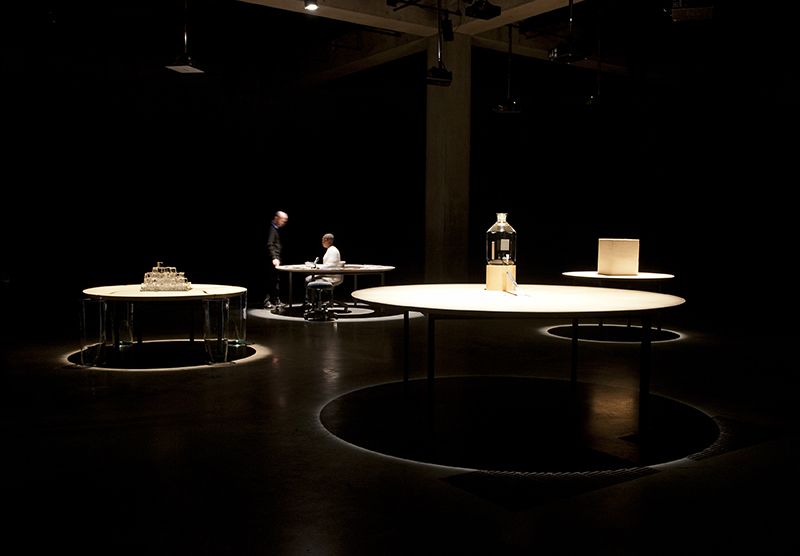 Otobong Nkanga (Nigerian/Belgian, b. 1974)
Otobong Nkanga (Nigerian/Belgian, b. 1974)
Contained Measures of Shifting States, 2012
Four wooden tables of various size with metal legs, felt, ice, glass aspirator on wooden cylinder, aluminum metal strip, 100 inkjet prints on laser-cut forex plates, heating plate, glass containers, dematerialized water
Installation space for discussion and observation, November 24, 2012, 9-hour performance
Installation view of Across the board: Politics of Representation at The Tanks at Tate Modern, 2012
In Contained Measures of a Kolanut (2012), a durational performance meant to engage the senses, Nkanga sat at a table for hours, inviting visitors to join her in breaking open and eating kola nuts. The kola nut, which Nkanga remembers tasting as a child in Nigeria, plays an important role in West African culture and social life. In the 19th century, the evergreen seed, sometimes spelled “cola nut”, was taken to the Americas, where it became a lucrative crop, including its historical use as a caffeine-bearing ingredient in Coca-Cola. During the performance, visitors were prompted to savor the kola nut, fostering an opportunity for open dialogue with the artist, who ingested energy from both the nut and her audience as the day went on. Through this interaction, artist and viewer forged something new: a conversation or shared understanding that transcended the performance’s physical elements. As Nkanga describes it, Contained Measures of a Kolanut is "really about dissecting the plant and looking at it in all kinds of different ways. It’s really a moment to share. And the kola nut is there to open that conversation."6
The importance of dialogue with the audience likewise emerged in Nkanga’s 2012 Tate exhibition Contained Measures of Shifting States, a durational performance that saw the artist sitting in the museum at a table with 100 photographs featuring art in the Tate’s collection, Nkanga’s previous works, and imagery of landscapes, maps, and other cultural references; the images served to prompt conversations between the participant and Nkanga. Improvising with the audience over the course of a nine-hour day opened the possibility that the knowledge Nkanga and her interlocuters had gathered and shared could be transmitted, thus allowing the work to live beyond the immediate moment. Nkanga extended this concept in Landversation, which comprised five tables animated by five different groups, communities, or persons that have a deep connection to land. Since 2014, versions of Landversation have been presented in Brazil, Lebanon, China, and Bangladesh.
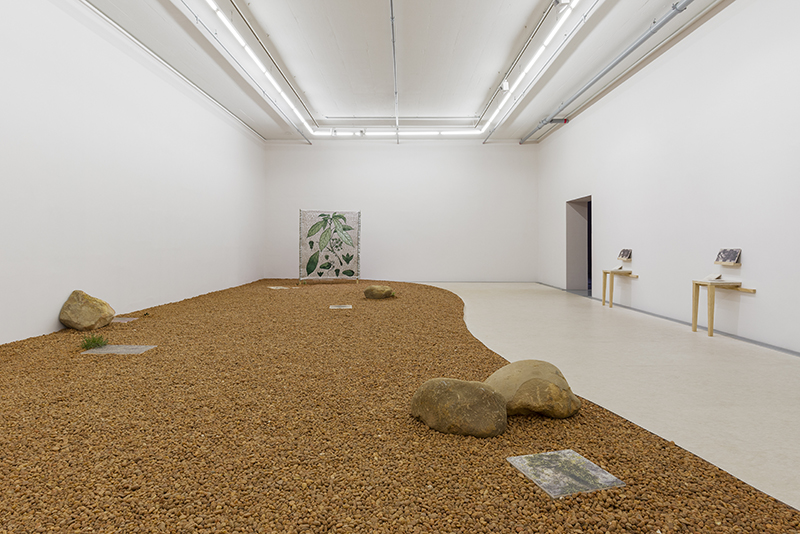 Otobong Nkanga (Nigerian/Belgian, b. 1974)
Otobong Nkanga (Nigerian/Belgian, b. 1974)
Taste of a Stone, 2010/19
Namib Red pebbles, Echeveria Lehani, Crassula muscosa, Plectranthus variegated, Gasteria Barberton, Plectranthus Strigosus Blue, reindeer moss, various rocks from the Cape Town area, inkjet prints on Galala limestone slabs
Kolanut Tales–Dismembered, 2016, woven textile (yarns: polyester, organic cotton, linen, acryl), 82 4/5 x 68 4/5 inches (210 x 175 cm)
Installation view of Acts at the Crossroads at MOCAA–Zeitz Museum of Contemporary Art, 2019
Photo: Dillon Marsh
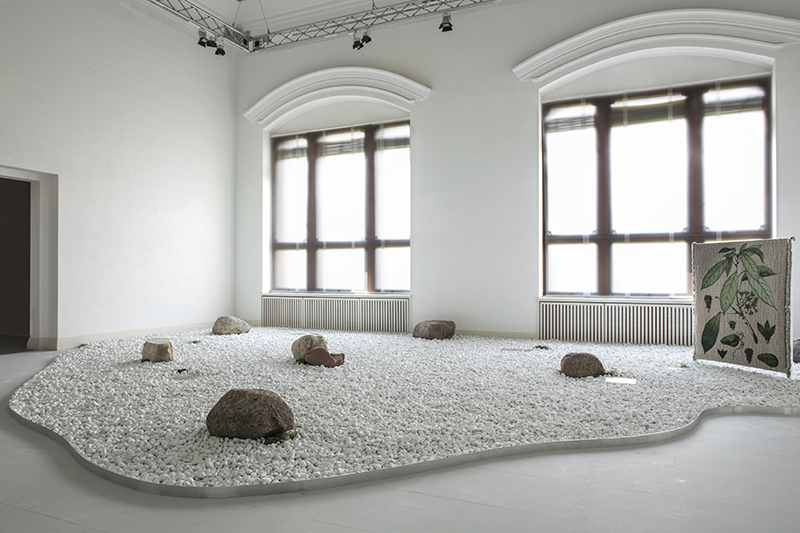 Otobong Nkanga (Nigerian/Belgian, b. 1974)
Otobong Nkanga (Nigerian/Belgian, b. 1974)
Taste of a Stone, 2010/20
Marble pebbles, Hedera Helix, Sempervivum arachnoideum, Sedum acre, Sedum rupestre, Linaria alpina, Tillandsia multiflora, Tillandsia straminea, Tillandsia aeranthos clump, reindeer moss, boulders, gneiss, granite, Iceland lichen, inkjet prints on Galala limestone slabs,
Kolanut Tales–Dismembered, 2016, woven textile (yarns: polyester, organic cotton, linen, acryl), 82 4/5 x 68 4/5 inches (210 x 175 cm)
Installation view of Otobong Nkanga: There’s No Such Thing as Solid Ground at Gropius Bau, 2020
Photo: Luca Girardini
Memory also plays an important part in many of Nkanga’s works. Taste of a Stone (2010) tapped into the universality of natural elements such as plants, stones, sand, and water to construct an environment rich in personal associations for both visitors and performers. Visitors had the opportunity to walk on the installation’s gravel bed, immersing themselves in its sounds, scents, and sensations, while performers were invited to use the space to stage their own engagement with the materials. In this setting, Nkanga unlocked the deep-seated significance that stone can carry both on a personal and human level. She explained, “When we think of a stone we can think of it as a thing to mark a territory. We can think of it as a weapon, we can think of it as a souvenir. The way we use this material goes beyond just the material itself. We resonate with it spiritually in a very emotional way. I think people can find their own way through all these different ways that we have used this material in history and political revolts, in love stories and so on.”7
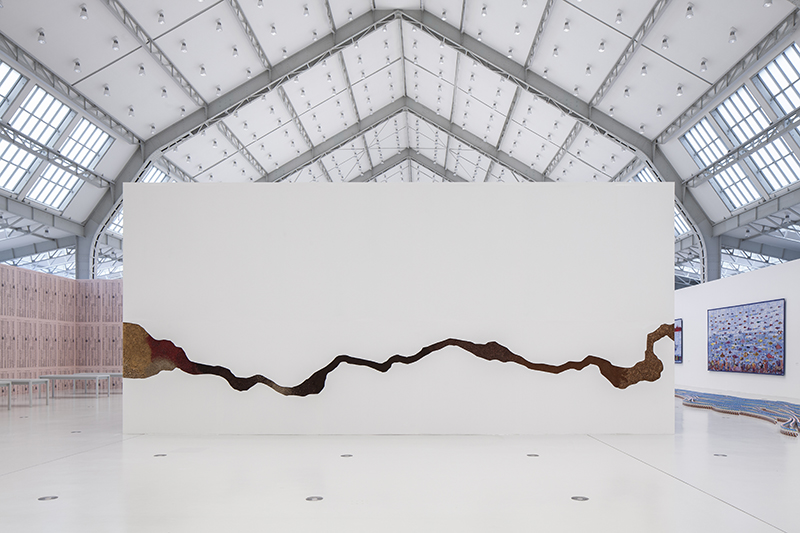 Otobong Nkanga (Nigerian/Belgian, b. 1974)
Otobong Nkanga (Nigerian/Belgian, b. 1974)
Anamnesis, 2015
Plywood, gauze, coffee, tea, spices, cacao, raw tobacco, peat 204 3/5 x 451 1/5 inches (520 x 1146 cm)
Installation view of Streamline., Ozeane, Welthandel and Migration. Oceans, Global Trade and Migration at the Deichtorhallen, 2015
Nkanga’s chosen materials often attempt to connect with the viewer on a visceral level. In a recent installation at Sint-Janshospitaal, part of the Musea Brugge, Belgium, the artist included a new iteration of Anamnesis (2015/2022). The work, made initially in 2015, comprises a large wall riven with a fault line with teas and spices that scent the air. For the presentation in Brugge, the artist used aromatic goods that were once traded there to document connections between people and cultures that began when the space served as a medieval hospital. The work connected with present-day visitors by conjuring memories from the fragrances and flavors associated with the frankincense, myrrh, tea, tobacco, coffee, and peppercorns embedded in the wall.
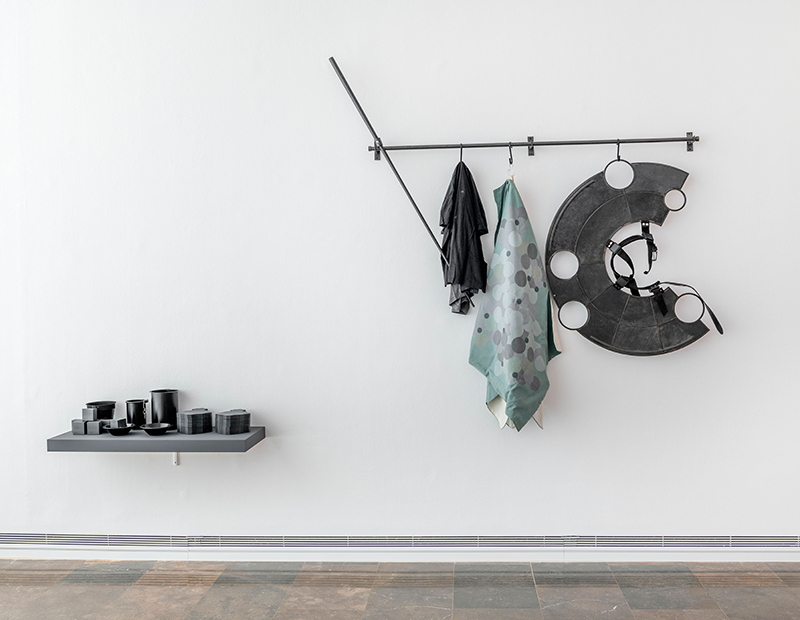 Otobong Nkanga (Nigerian/Belgian, b. 1974)
Otobong Nkanga (Nigerian/Belgian, b. 1974)
Carved to Flow: Germination, 2017
1,000 O8 Black Stone soaps (cold process hand-made natural soap, butters and oils from across the Mediterranean Middle East, North and West Africa, fused together with water, lye, and charcoal)
2 2/5 x 2 2/5 x 1 3/5 inches (6 x 6 x 4 cm) each soap, stacked on 3 wooden platforms
500 paper boxes printed with 8 different poems, metal structures, pointed wooden sticks, costumes for performers made in wood, metal and leather, belt, buckles, cotton clothes, cotton drapes printed with texts, formula of the O8 Black Stone soap and 8poems, laurel plants, earth, black stickers, natural sponge, metal containers, water
Hexagonal wooden structures with engraved poems, list of ingredients of the soaps and texts, containing 10 blocks of different types of soap of 3 7/8 x 23 5/8 inches (10 x 60 cm)
Installation view of Craving for Southern Light at the IVAM Centre Julio González, 2023
Photos: IVAM Centre Julio González
In addition to enlisting a variety of senses, materials, and formats, Nkanga’s projects may extend through additional iterations over different venues, countries, and circumstances. For Carved to Flow, created for documenta 14 in 2017, Nkanga directed the creation of bars of soap resembling blocks of marble from ingredients gathered from sites in Africa, the Mediterranean, and the Middle East. These soaps were processed in Athens, Greece—one of the sites of that year’s Documenta—then shipped to the main exhibition site in Kassel, Germany to be displayed and sold. The project has continued with The Carved to Flow Foundation, established in Akwa Ibom, Nigeria, which funds two distinct initiatives: an organic farm outside of Akwa Ibom, and Akwa Ibom Athens, a nonprofit art space which has staged exhibitions of previously below-the-radar artists. This complex “flow” of production and commerce echoed the properties of the soap itself—its mutability through changes of temperature and other environmental shifts.
The movement of soap and its component elements offers a tangible demonstration of Nkanga’s observation that the movement of goods across national borders is often easier than the movement of people. As someone who was born in Nigeria and grew up there and in France followed by advanced studies in the Netherlands, Nkanga is well acquainted with the complexities of traveling through and living in different cultures and how those cultures may regard and interact with one another.
A performance of 2014, Diaspore, featured women of African descent moving around a topographical map, humming and balancing Queen of the Night plants (also known as night-blooming jasmine) on their heads. Their interaction illustrates how displaced persons must continually negotiate their position in a new place among unfamiliar people. For those encountering this performance, the slow movement, gently persistent melodies, and heady fragrance offered a poetic meditation on the dispersal of music, aromas, and people over time and space. Both viewers and performers are meant to feel that they are stepping into someone else’s territory when they enter the artwork, provoking thoughts of migration and its political dimensions.
Nkanga’s profound connection to materials, regardless of origin or location, embodies her concept of being grounded or rooted not to a specific place but to the very substances of the Earth. She describes encounters she has had—“a taste of something, the smell of something, a certain color, a mineral”8—that trigger vivid memories of her youth even when she is far from her childhood home. For Nkanga, the concept of rootedness, which figures into drawings like Whose Crisis Is This? (2013) and Social Consequences IV: The Takeover (2013), in which bodies are literally rooted to the ground, isn’t linked to geographical or national boundaries but rather to the land itself. This concept pervades several of her projects, where she uses ropes, threads, and other connective materials to join dispersed forms.
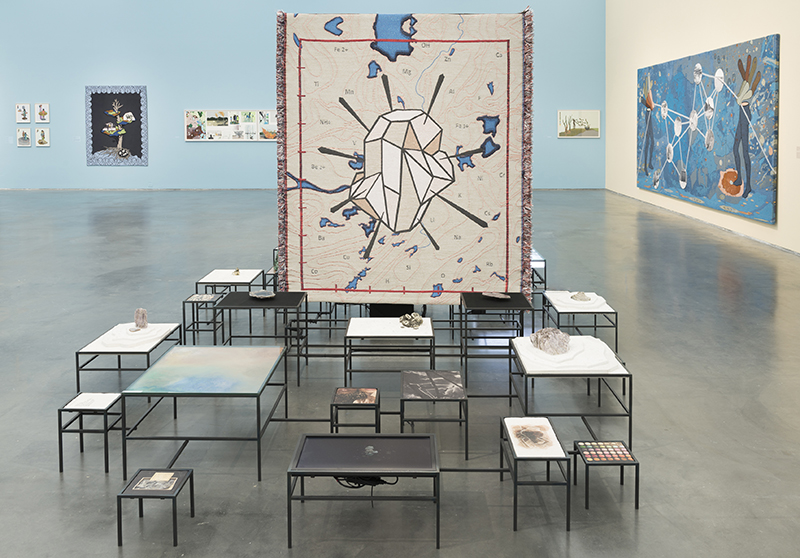 Otobong Nkanga (Nigerian/Belgian, b. 1974)
Otobong Nkanga (Nigerian/Belgian, b. 1974)
In Pursuit of Bling, 2014
Metal modulated structure of 30 elements; 9 photographic prints on Galala limestone slabs, 6 slabs with minerals in layered concrete, 4 levitation modules with minerals (various mica), 3 texts printed on Galala limestone slabs, 2 woven textile pieces (In Pursuit of Bling–The Discovery; In Pursuit of Bling–The Transformation), 2 single-channel HD videos with sound, occasionally on headphones (In Pursuit of Bling, 11:59 min; Reflections of the Raw Green Crown, 2:52 min), 1 micanite sheet, 1 lightbox with 30 inkjet-printed archival images on plexiglass, 1 copper sheet with malachite head piece, 1 compressed makeup powder tray
Installation view of Otobong Nkanga: To Dig a Hole That Collapses Again at the Museum of Contemporary Art, Chicago, 2018
The artist’s frequent references to the interconnectedness of body and landscape serve as a compelling call to nurture and protect the Earth. Nkanga posits that the lands we inhabit are inherently linked to our bodies, and when that land is mistreated, our bodies suffer too. A visit to an abandoned mineral mine in Namibia, by then only a great crater in the land, was crucial in Nkanga’s connecting the land with the body, as well as the broken bodies and lives of those who worked the mine, and the exploitative nature of its economies. The experience found expression in a number of installations including In Pursuit of Bling (2014), Solid Maneuvers (2015), and Tsumeb Fragments (2016), where Nkanga incorporated minerals and metals such as mica, copper, aluminum, and salts.
Nkanga’s stewardship of and advocacy for land and the people who rely on it can be interpreted as a protest against forces driven by excessive consumption and the profits from extraction of natural resources. “To care,” Nkanga has stated, “is a form of resistance. We have to enter into the space of resistance—of singing together and caring for each other’s souls.”9
Otobong Nkanga demonstrates tremendous ambition in the way she considers the materials of her artworks, pursuing a holistic understanding of the substances with which she builds. She brings sensitivity and focus to the formal and sensuous qualities of the land’s resources, creating interactions with complex systems that underline how enmeshed we are with the earth, its contents, and each other.
1 Nkanga, Otobong. Interviewed by Helen Welford. “Hearing from Artists: Otobong Nkanga,” MIMA, May, 2020, mima.art/wp-content/uploads/2021/07/FINAL-Otobong-Nkanga-MIMA-Interview-18062020.pdf. Accessed September 2023
2 Beatrice Barrois, “Ways of Humanity: A Talk with Otobong Nkanga” December, 2016.
3 Posted 16th January 2013 by Zaynnah Magazine zaynnahmagazine.blogspot.com/2013/01/a-conversation-with-otobong-nkanga. Accessed September 2023
4 Nkanga, Otobong. https://www.otobong-nkanga.com/landversation. Accessed September 2023.
5 Vukadin, Ana. “Otobong Nkanga: Castello di Rivoli,” Art Forum, 2021, artforum.com/events/otobong-nkanga-3-249493/. Accessed September 2023
6 Hotchkiss, Sarah. “Displacement Fuels Questions in Artist Otobong Nkanga’s Performances.” KQED, May 11, 2016 https://www.kqed.org/arts/11569322/displacement-fuels-questions-in-artist-otobong-nkangas-performances. Accessed September 2023
7 Steiwer, Louise. “Ten Questions: Otobong Nkanga.” Kunstkritikk, March 31, 2017. https://kunstkritikk.com/ten-questions-otobong-nkanga/.
8 Hotchkiss, Sarah. “Displacement Fuels Questions in Artist Otobong Nkanga’s Performances.” KQED, May 11, 2016. https://www.kqed.org/arts/11569322/displacement-fuels-questions-in-artist-otobong-nkangas-performances. Accessed September 2023
9 Otobong Nkanga, “That Place of Breathing Together: A Conversation between Stephanie Rosenthal and Otobong Nkanga,” interview by Stephanie Rosenthal, Otobong Nkanga: There’s No Such Thing as Solid Ground (Berlin: Gropius Bau, 2020), 47.